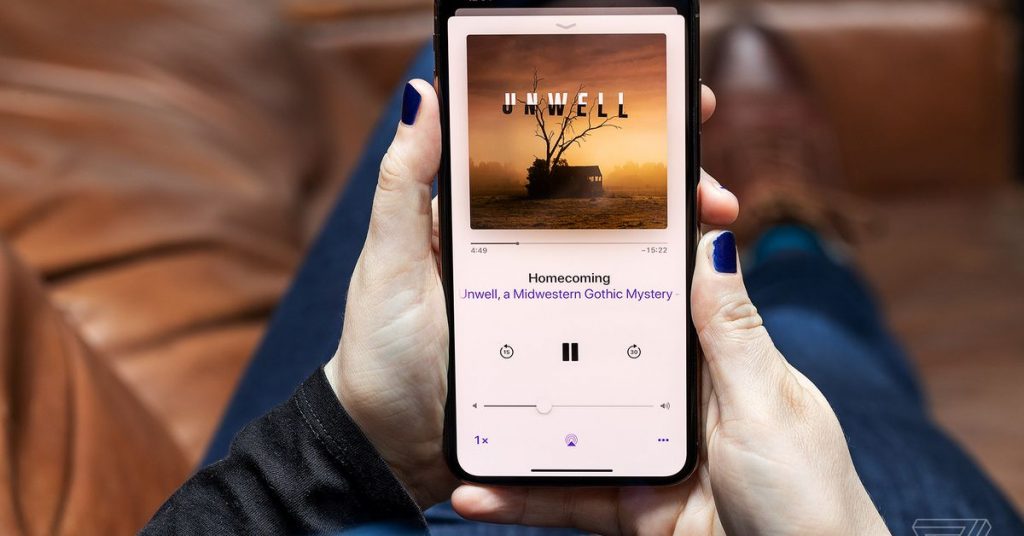Unwell is a fantastic gothic horror podcast set in midwest America
There are a ton of podcasts out there, but finding the right one can be difficult. In our new column Pod Hunters, we cover what we’ve been listening to that we can’t stop thinking about.
HartLife’s new podcast series Unwell is a good example horror storytelling. After her mother is injured, a woman named Lillian Harper moves in with her mother in the very small town of Mt. Absalom, Ohio to help her recover. When she arrives, she rediscovers the strangeness of small-town middle America. Lillian and her mother have been estranged for years, and when she returns to her mother’s home — a boarding house that’s been in her family for generations, she comes across a host of strange characters, as well as deep-seated conspiracies and ghosts.
The show sits nicely alongside other shows that have come out in recent years, like straight-up horror stories like the BBC’s The Case of Charles Dexter Ward, an adapted a story by H.P. Lovecraft, or nonfiction programs like This American Life’s S-Town, about a man named John whose story plays out like an elaborate southern gothic novel.
You can listen to Unwell on its website, as well as Apple Podcasts, Libsyn, PlayerFM, Spotify, and Stitcher. (Transcripts of each episode are also available on the show’s website.)
:no_upscale()/cdn.vox-cdn.com/uploads/chorus_asset/file/16006329/R2_Unwell_CoverArt_1000x1000.jpg)
Image: HartLife NFP
The show’s executive producers, Jeffrey Gardner, and Eleanor Hyde told The Verge that they conceived of the story more than two years ago while working on another series, Our Fair City, and have spent the time since then refining the concept and developing bigger narrative arcs.
Gardner says that they lived in central Ohio for a number of years during their time as an undergraduate in college, and that the rural setting is one that’s “near and dear” to their heart. “But it’s also a world that really meshes well with the kind of gothic horror which we so often think of as big Victorian mansions and the British countryside. That is really awe-inspiring in the old-school terror way, and I was interested in telling stories in that context.”
“We started this project with sort of a seed of an idea that we wanted to tell a story in that setting,” Hyde adds, noting that there was a lot of freedom with what that would look like. As they and their four-person writing team began to tackle the project, she notes that “there was a lot of interest in exploring the idea of what it means to be American. We all live in Chicago, and have this midwestern idea of that, and being able to take that story DNA about small-town Midwest and retell it in a way that felt like it reflected our experience as Americans and what that means in many different kinds of ways.”
A big focus, Gardner says, is looking at memory and the types of relationships people form with parents who are aging. “For a lot of us, we’re dealing with parents who are dealing with signs of dementia or Alzheimer’s and other degenerative things like that.” Hyde points out that there isn’t a lot of fiction that deals with this sort of generational shift, that involves these sorts of changing relationships. “So, I guess we have to write some of them ourselves if we can’t find them.”
The pair have big plans for the series as well. Hyde explained that they’re midway through the writing of season 2, and they’re at the point where they’re working on tying together some of the events to a much larger story that they’ve been planning for the series, from the experiences of the characters and everything that’s going on in their lives, to what’s going on with the town. “On a macro-level, how do these things feed into each other and speak to each other on a different level,” Hyde says.
Parts of the series feels as though it’s akin to shows like Twin Peaks or Sharp Objects: stories set in, and dealing with characters who live in insular communities. It’s a type of story that has a long history within horror canon, and lends itself well to supernatural mischief. “There is deliberately a lot of play between what is supernatural, and what is the weirdness of a small town,” Gardner says. “We’re really interested in playing with some of that being surprising of [what] people see the first time they go through this weird small town. And then by the end fo the series, you’ll be able to piece together things from season one, and season four or season two, and say ‘Oh, I understand how this all fits together.”
Gardner says that audio is particularly well suited for the type of story that they’re telling, because they can’t rely on visual cues. They say that the entire production crew spent a lot of time making sure that the timing of their dialogue and the sound of the world feels realistic to audiences. Hyde specifically noted the work of their lead sound designer, Ryan Schile. “The underlying narrative logic that underpins [the show] has to be translated into [an] underlying auditory language that makes the world work.” There’s a point in the series where this really stands out: an argument between Lillian, someone she’s speaking with on the phone, and her mother in Episode 4 feels extremely tense, not only because of the content, but because of how their voices overlap as the characters talk past one another, and how the producers used the sense of space within the house as a fixture. It’s an effective, thrilling moment that feels extremely realistic and uncomfortable to listen to, as though we’re a fly on the wall.
One notable element in the production that jumped out at me in the podcast comes at the end of each episode: an indigenous people’s acknowledgement that lists off the tribes that used to live in Chicago and southern Ohio. Hyde acknowledged that she wasn’t an expert in the field, but explained that the practice was more common in Canada, and they consulted with experts to figure out the right way to do it. “While there aren’t any native characters in the story at this point, understanding that that’s an important part of the American story, and wanting to acknowledge it.” By incorporating it into their series and website, Hyde says that it’s a first step towards raising some awareness of this particular movement, and towards making it a normal practice elsewhere.
Now is a very good time to jump in and get caught up on the show. The series recently aired the first six episodes of its first season, and is taking a short break before airing the second half in May.
You may be interested

You can easily disassemble this repairable smartwatch using just a Phillips screwdriver
admin - Nov 22, 2024[ad_1] The Spectra is a new smartwatch designed from the ground up to be hackable and easy to repair. It…

Ed Sheeran 'helped Ipswich sign player' before appearing with Taylor Swift
admin - Nov 22, 2024[ad_1] Ed Sheeran helped Ipswich Town to sign a player over the summer just before getting on stage with Taylor…

Strava closes the gates to sharing fitness data with other apps
admin - Nov 20, 2024[ad_1] We wanted to provide some additional context around the changes to our API Agreement and the impact for our…
Leave a Comment
You must be logged in to post a comment.























